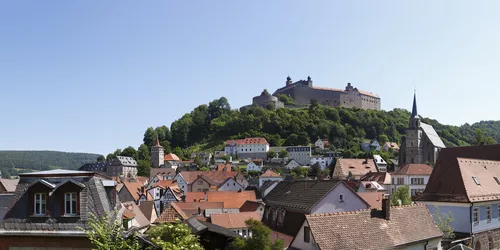The Plassenburg: A journey through Kulmbach's history
Almost 900 years old, Plassenburg Castle was once the centre of power of the Hohenzollern dynasty. Today, behind the walls of this beautiful Franconian town are four museums about life and the military of the time.

A landmark with almost 900 years of history
Anyone who has ever been to Kulmbach or driven past it has definitely seen it from afar: Plassenburg Castle. It towers majestically over the small town of 26,000 inhabitants. Its motif adorns numerous postcards on the stands in front of the souvenir shops. The people of Kulmbach are rightly proud of their castle, where the Hohenzollern dynasty once lived and ruled. After all, it is one of the most imposing Renaissance buildings in Germany and is already 900 years old. Since it was first mentioned in 1135, the castle has been besieged in several wars, blown up by enemies, served as a prison and held unwelcome members of the rulers' families captive in its towers. These and many other stories are told in the four museums located behind the walls of Plassenburg Castle.
The Obermain Landscape Museum: Medieval world map and more
In the Obermain Landscape Museum, historical furniture and paintings convey a sense of the bourgeois life of Kulmbach's inhabitants at the time. A replica of the Ebstorf world map from the late 13th century also hangs here. It was the most comprehensive world map of the Middle Ages, although it is not a true-to-scale replica of the earth, but rather depicts the historical and theological knowledge of the time. The approximately 2,300 drawings also include several illustrations of people and mythical creatures. A tip: Plassenburg Castle can also be seen on the map. Who can find it first?
Tin figure museum: the largest collection in the world
You can marvel at the largest collection of pewter figures in the world at the German Pewter Figure Museum: 300,000 little Romans, Germanic tribes, knights, peasants and fairytale figures live here. It is also home to the world's largest diorama - the name given to a display case in which a scene is depicted. 19,385 elaborately painted pewter figures recreate 26 November 1553, when Bohemian troops almost completely destroyed the town of Kulmbach.
Hohenzollern Museum: Living like the rulers
How did the Hohenzollerns live at the castle back then? The Hohenzollern Museum in Franconia is located in the former living quarters of the ruling family and gives you an impression of Baroque life at Plassenburg Castle. Other museum rooms show the development of the castle from the Middle Ages to Prussian rule.
The Army Museum: Soldier life in the 18th century
The Frederick the Great Army Museum vividly shows what life was like as a soldier in the 18th century: how were the men paid, what exactly is a gauntlet and did camp life mean adventure or danger for the troops? In addition to this exhibition, you can also marvel at the world's largest collection of old Prussian firearms and many flags and paintings.
Current information, admission prices and opening times can be found here.
Culinary finale at Kommunbräu Kulmbach
After exploring Kulmbach's past, savour the Franconian cuisine. A particular speciality in Kulmbach is the "Blauen Zipfel", a bratwurst cooked in vinegar and then served with onions and bread rolls, for example in the Kommunbräu Kulmbach restaurant. Did you know that Kulmbach, with its seven breweries, is also known as the unofficial capital of beer? At Kommunbräu, you can sample a speciality beer every month in addition to the classic pale and amber beers.
Getting to the Plassenburg: how to get there
It's a 20-minute walk from Kulmbach train station to the castle. To get there, first walk eastwards from the station along Heinrich-von-Stephan-Straße. After about 90 metres, you will come to a crossroads. Turn right here onto Kronacher Straße. After another 140 metres, this becomes Sutter Straße. Just stay on it and continue until Grabenstraße leads off to the left. Turn right there and after just under 100 metres turn right again onto Röthleinsberg. After 200 metres, turn left into Obere Buchgasse. Follow it until it forks and then turn right. The street "Festungsberg" should now be in front of you. Keep left and follow it to your destination.
The Kommunbräu Kulmbach is only a 14-minute walk from the castle. Simply walk back over the Festungsberg that you came over. Turn sharp right at Obere Buchgassen and follow it until the path forks and you turn left into Gutmannsgäßchen. Follow it to Fischergasse and turn right there. The road soon becomes the "Grünwehr". Stay on the road until the junction and then keep right. The address is: Grünwehr 17.
Arrival
Festungsberg 26
9532 Kulmbach
Kulmbach
Our tip: Please make sure to check your train connection and the expected capacity before you start your journey.